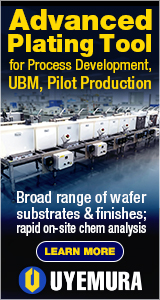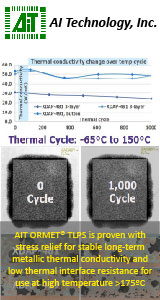|

|
|
| Ask the Experts | |||||||
|
|||||||
|
June 16, 2021 - Updated July 4, 2007 - Originally Posted Double sided SMTCan you provide some process pointers on soldering 2 sided SMT? Bernie Irving |
|||||||
| Expert Panel Responses | |||||||
|
The number of variables associated with SMT processing of a single-sided board is staggering. Adding a 2nd side makes the situation even more complex! One key common to all SMT process success is process control. Utilizing test and inspection in the correct balance and configuration to match your line's goals will help achieve process control. Without more information it is difficult to assess at what points your production line(s) would benefit most from a test and inspection insertion but knowing that you are doing 2 sided or doube-sided boards you will need to consider an inspection technique that enables you to test both sides of the boards simultaneously. Doing this can help identify process defects in a 2 sided configuration which can enable you to identify upstream processes to target and/or variables to focus on.
Americas Marketing Development Manager Agilent Technologies Ms. Johnson's entry into the electronic packaging arena was as a Package Development Engineer. Stacy recently joined the Americas Field Marketing Organization as a Marketing Development Manager for the Americas where she continues to work on AOI, AXI and also In-Circuit Test.
NOTE: Ms. Johnson is no longer working at Agilent Technologies. Double sided surface mount products have been manufactured for many years and the process is typically the same as it is for products manufactured with components only on one (1) side. Review the profile to include the extra mass of the components on side 1. Review the weight of each component that will be on side (1) during the second side reflow as these solder joint will become liquidus and you are expecting the surface tension of the solder to hold these components in place. Review the thermal profile across the entire board, front – back – sides – top and bottom, the total delta of temperature should not exceed 5 to 10 C. Make sure your conveyor is keeping the boards up off the belts. Make sure your boards do not warp or twists as they are being reflowed the second time or for the first time for that matter as this will impact solder joint reliability. These are just some of the issues needing immediate attention and I would suspect more information will be provided by others on this questions. If more help is needed please get in touch with one of us and we should be able to provide more in depth advise.
Vice President, Technical Director EPTAC Corporation At EPTAC Corporation, Mr. Lambert oversees content of course offerings, IPC Certification programs and provides customers with expert consultation in electronics manufacturing, including RoHS/WEEE and lead free issues. Leo is also the IPC General Chairman for the Assembly/Joining Process Committee.
Design the board so that heavy components (power components, large BGAs, etc.) are on one side (the second side). Make sure you have good support under the board during the second reflow. Customize the profile for each side (it won't necessarily be the same). Depending upon the design, you may need to shield the first side from the peak temperatures during the second reflow.
CEO & Managing Partner DfR Solutions Dr. Hillman's specialties include best practices in Design for Reliability, strategies for transitioning to Pb-free, supplier qualification, passive component technology and printed board failure mechanisms.
The best way to look at double sided SMT assembly is to break it down into 2 single sided SMT assemblies. This is how you will process the board. Most assemblers will process the higher density side first, since this side requires more heat. Doing it this way, when you reflow the low density side, you have a lower risk of dropping off components due to the thermal requirements of the board. If you choose to reflow both sides simultaneously, the less complicated side will require the addition of SMT adhesive, this extra step will insure that the components on the bottom stay in place during the heating operation. Keep in mind this will require an extra step, it will be more difficult to reflow and it also makes rework harder due to the stuck on parts.
Regional Sales Manager OK International Inc. Ed Zamborsky is a Regional Sales & Technical Support Manager for Thermaltronics, located in New York. His position requires frequent customer visits throughout North America and the Caribbean and his position encompasses not only sales but the role of trainer and master applications engineer for all of Thermaltronics products. His expertise includes such specialties as hand soldering, convection and conduction reflow techniques, array rework, fluid dispensing equipment, and fume extraction. Ed has authored many articles and has presented many papers on topics such as; Low Volume SMT Assembly, Solder Fume Extraction, SMT Rework, BGA Rework, Lead-Free Hand Soldering, High Thermal Demand Hand Soldering, Lead Free Visual Inspection and Lead Free Array Rework.
Do not underestimate the importance of proper board support for your double sided application. First and foremost, a robust SMT process requires an accurate print with volumetric repeatability. One critical factor to a quality print is the board support. Without proper support, the board will bow downward during the print stroke increasing the volume of paste transferred, encouraging bridging. Single side builds are relatively easy to support with simple support pillars which come with most stencil printers today. However, these same pillars are often the root cause of defects for double sided applications. Components on the bottom side limit the possible support areas available for that board. Even when there are enough open areas available, it isn't always easy for an operator to position the supports in the correct position. And how do you document these positions to eliminate this as a process variable in the future? Support pillars can be used if the component population isn't too dense, but these issues must be addressed in operator training and with setup protocols in place to ensure a repeatable process. Dedicated tooling, a blank support plate with component locations routed out, provides process repeatability, but will also added cost. However, if the component density is too high, it still may not be possible to provide the support needed. In these cases compliant tooling is a solution. Compliant tooling modules have support rods with adjustable heights that lock in position once set. This method enables you to support the board even if there is a component present. For double sided applications, I've found money saved on inexpensive board support solutions is often spent many times over at the rework station.
Applications Supervisor DEK Mr. O'Hanlon serves as the DEK Applications Supervisor for the Americas region. He has over 20 years of electronics manufacturing experience and has spent the last 13 years at DEK providing equipment utilization and process solutions for SMT manufacturing.
|
|||||||
| Submit A Comment | |||||||
|
Comments are reviewed prior to posting. You must include your full name to have your comments posted. We will not post your email address. |
|
Free Newsletter Subscription
Circuitnet is built for professionals who bear the responsibility of looking ahead, imagining the future, and preparing for it. Insert Your Email Address |
|

|






